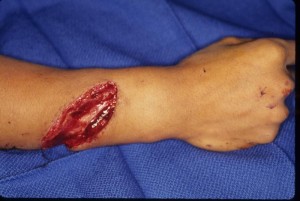First Aid 102/ Bleeding
By Spike Bowan
©forgdogwriting 2013
WARNING!! GRAPHIC PHOTOS! DON’T READ IF YOU’RE A WUSS!
I am going to cover a lot of different types of bleeding trauma and how to treat the injuries. This is a ton of information that I am going to be throwing your way so pay attention. If you don’t know a word use a search engine to look it up. You’re already on the computer/tablet/smartphone anyway. This is BASIC information. Emphasis on BASIC!
As in a Tactical situation, ALWAYS BE AWARE OF YOUR SURROUNDINGS.
SCENE SAFETY is key!!!
If whatever injured the patient is still present, i.e. downed electrical wires, rabid dog, crazy gunman etc…; you could be hurt as well. If you go down then no one is helping the patient and now you yourself are a patient. Don’t be that guy.
Lets start.
BLEEDING:
Blood has germs. If possible use BSI (Body Substance Isolation) Latex or Nitrile gloves can protect both you and the patient.
Bleeding can occur in man ways. Here are the more common:
- Incisions- Straight edges to the wound margins, as if sliced with a knife. These can vary in size, and may be caused by a variety of objects, including a knife, any piece of straight, sharp metal, or a piece of glass. Tissue is rarely missing from the wound site, and the edges of the wound may be easily matched from one side of the wound to the other for the purposes of closing the wound with stitches.

- Laceration- Jagged edges to the wound edges, more closely resembling a tear than a slice. The wounded tissue is random rather than straight in direction, and may have multiple branches. Most often caused by an object with a broken or serrated edge, such as a piece of broken glass or metal, but may also be caused by a blow from a blunt object to tissue with bone immediately behind it.

- Puncture: Sharp object penetrates the tissue, and travels internally, but does not move laterally in any direction from the point of entry. Such wounds can be misleading, as they may appear quite small on surface examination, but extend quite deeply into the body(Gun Shots/Stab Wounds); even damaging nerves, blood vessels, or internal organs. They may cause substantial internal bleeding or secondary injuries, such as a collapsed lung (pneumothorax/tension pneumothorax/hemopneumothorax), which may not be readily evident during primary assessment. Occasionally, the object causing the injury will remain in the wound as an impaled object. Medical professionals usually refer to this type of wound as penetrating trauma.

- ^STAB WOUND^ Leave the object in place!!! Everyone’s first instinct is to take it out! Don’t! pack around the object to stabilize it!


- ^ GSW (gun shot wound) look for exit wound
- Abrasion: A scraping or scratching. Generally quite superficial, and affecting only the surface layers of the epidermis(skin). No internal organs, nerves, or blood vessels other than capillaries, are affected. This may be the result of a fall, or of sliding (friction) against rough surfaces. The road rash often suffered by falling motorcyclists is an example of this type of wound.

- Contusion: Simple bruising. In this type of injury, the capillaries in the epidermis and dermis are damaged, without breaking the skin. Blood oozes out of these vessels into the spaces between cells or interstitial space causing swelling and discoloration. Blood loss is generally limited, and not of serious consequence. It may, however, act as a signpost, pointing to more serious injuries.

- Avulsion: A full thickness laceration-type wound, often semi-circular in shape. This creates a flap which, when lifted, exposes the deeper tissues to view, or extrudes them from the wound itself. Avulsions often occur in mechanical accidents involving fingers (sometimes referred to as degloving), and on a more serious note, may affect the orbit of the eye or the abdominal cavity, exposing the internal viscera. Avulsions are difficult to repair, and no avulsion should ever be considered a minor injury.

There are 3 types of bleeding:
-Capillary Bleeding = Capillary bleeding usually occurs in superficial wounds, such as abrasions. The color of the blood may vary somewhat (distal portion of circulation with oxygenated and unoxygenated blood mixing), and will generally ooze in small amounts, as opposed to flowing or spurting
-Venous Bleeding= This blood is flowing from a damaged vein. As a result, it will be purplish almost black in color (due to the lack of oxygen in it) and will flow steadily. While the blood loss may not be arterial, it can still be quite substantial, and can occur with surprising speed without intervention.
-Arterial Bleeding=As the name suggests, blood flow originating in an artery. With this type of bleeding, the blood is typically bright red to yellowish in color, due to the high degree of oxygenation. Blood typically exits the wound in spurts, rather than in a steady flow. The amount of blood loss can be copious, and can occur very rapidly.
CALL 911
-Applies direct pressure to the wound
If the wound continues to bleed.
-Applies tourniquet if possible. (Obviously if the patient is bleeding from the head, you’re not going to put a tourniquet around their neck.)
-If the patient is exhibiting signs and symptoms of hypoperfusion or shock; cool clammy skin, diaphoresis (sweating) altered level of consciousness, weakness..
Properly positions the patient by elevating their legs. This keeps the blood toward the core of the body.
-Initiates steps to prevent heat loss from the patient. Cover the patient with a blanket.
Pretty simple right? Now this is for moderate to severe bleeding. Teeny Tiny Little scrapes and cuts (paper cut etc…) can be washed with soap and water and you can use a band aid and triple antibiotic ointment.
More to come: Keep checking back for more BLOGS.
Check out my FB
https://www.facebook.com/frogdogwriting
Information Based off of NREMTP (National Registry Emergency Medical Technician Paramedic) Standards
CHECK out MY BOOKS on KINDLE and NOOK
KINDLE
http://www.amazon.com/s/ref=nb_sb_noss_1?url=search-alias%3Daps&field-keywords=Spike%20Bowan
NOOK
http://www.barnesandnoble.com/s/Spike-Bowan?store=allproducts&keyword=Spike+Bowan





